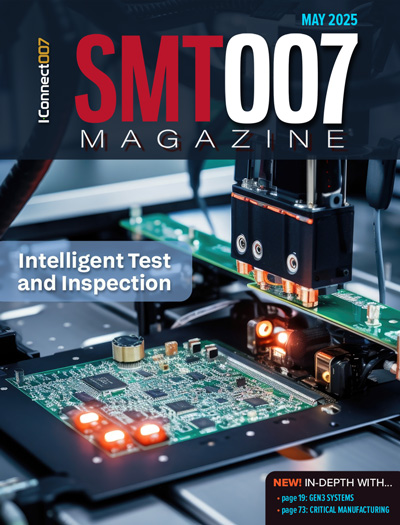-

- News
- Books
Featured Books
- smt007 Magazine
Latest Issues
Current Issue
What's Your Sweet Spot?
Are you in a niche that’s growing or shrinking? Is it time to reassess and refocus? We spotlight companies thriving by redefining or reinforcing their niche. What are their insights?

Moving Forward With Confidence
In this issue, we focus on sales and quoting, workforce training, new IPC leadership in the U.S. and Canada, the effects of tariffs, CFX standards, and much more—all designed to provide perspective as you move through the cloud bank of today's shifting economic market.

Intelligent Test and Inspection
Are you ready to explore the cutting-edge advancements shaping the electronics manufacturing industry? The May 2025 issue of SMT007 Magazine is packed with insights, innovations, and expert perspectives that you won’t want to miss.
- Articles
- Columns
- Links
- Media kit
||| MENU - smt007 Magazine
Z-AXIS Expands Custom Wire and Cable Assembly Production
September 18, 2020 | Z-AXISEstimated reading time: 1 minute
Z-AXIS, Inc. has expanded its production capacity for custom cable assemblies and wire harnesses, with a $40,000 investment in automated production and test equipment at its contract design and manufacturing center near Rochester, NY. The new equipment includes a Panduit CP Series ferule crimp press, a Kingsing KS-W66 Series heavy duty rotary cable stripper, a Gamma Mark III Plus heat shrink label printer, and a CableEye continuity tester.
“Custom cable assemblies and wire harnesses are essential for commercial, industrial and medical electronic equipment,” said Michael Allen, President of Z-AXIS. “With continuous investment in automation we boost capacity and throughput, keep costs down for our customers, and continue to meet high quality standards. Whether it’s cable assemblies, printed circuit board assemblies (PCBAs) or full box build services, we support leading customers with electronics manufacturing in the USA.”
The Panduit ferule crimp press supplements existing AMP K presses. It automates wire stripping, ferrule placement, and ferrule crimping with an average cycle time of less than 1.5 seconds. The programmable system with vibratory-bowl feeder accommodates loose-piece ferrules from 24 to 12 AWG. Integral wire stripping eliminates the need to use pre-stripped wire, saving a step and preventing the installation of ferrules onto any turned-back strands, which can result when using pre-stripped wire.
The Kingsing rotary cable stripper is optimized for co-axial, tri-axial, and other multi-layered cable stripping in up to nine layers. It supports full stripping, half stripping, middle stripping and twisting. It is easily programmable for cable diameter, stripping length and pull-off length. Precision cable centering and rotary blades delivery highly accurate cutting, removing the insulation close to the conductor for reduced pull-off force. It supports complex cable assembly production with high processing speeds.
The Gamma label printer prints on heat shrink tubing at high speeds, up to 11 inches per second, and cuts the tubing to specifications. The tubing is then applied to cables from 1/16” to 2.5” in diameter. High-resolution printing clearly identifies cables, while the heat shrink tubing can be used to provide strain relief.
The CableEye test system checks basic continuity and detects opens, shorts, mis-wires and intermittent connections in a wire harness or cable assembly. It features 128 test points and handles cables with up to 64 conductors. The test bed accommodates more than 200 standard connector types
Testimonial
"The I-Connect007 team is outstanding—kind, responsive, and a true marketing partner. Their design team created fresh, eye-catching ads, and their editorial support polished our content to let our brand shine. Thank you all! "
Sweeney Ng - CEE PCBSuggested Items
TRI to Exhibit at SMTA Queretaro Expo 2025
07/16/2025 | TRITest Research, Inc. (TRI), the leading provider of test and inspection systems for the electronics manufacturing industry, is pleased to announce plans to exhibit at the SMTA Querétaro Expo 2025, scheduled to take place on July 24, 2025, at the Querétaro Centro de Congresos y Teatro Metropolitano.
Knocking Down the Bone Pile: Addressing End-of-life Component Solderability Issues, Part 4
07/16/2025 | Nash Bell -- Column: Knocking Down the Bone PileIn 1983, the Department of Defense identified that over 40% of military electronic system failures in the field were electrical, with approximately 50% attributed to poor solder connections. Investigations revealed that plated finishes, typically nickel or tin, were porous and non-intermetallic.
Meet the Author Podcast: Martyn Gaudion Unpacks the Secrets of High-Speed PCB Design
07/16/2025 | I-Connect007In this special Meet the Author episode of the On the Line with… podcast, Nolan Johnson sits down with Martyn Gaudion, signal integrity expert, managing director of Polar Instruments, and three-time author in I-Connect007’s popular The Printed Circuit Designer’s Guide to... series.
TTCI Joins Printed Circuit Engineering Association to Strengthen Design-to-Test Collaboration and Workforce Development
07/09/2025 | The Test Connection Inc.The Test Connection Inc. (TTCI), a leading provider of electronic test and manufacturing solutions, is proud to announce its membership in the Printed Circuit Engineering Association (PCEA), further expanding the company’s efforts to support cross-functional collaboration, industry standards, and technical education in the printed circuit design and manufacturing community.
Study on Resonance Mitigation in Metallic Shielding for Integrated Circuits
07/08/2025 | Maria Cuesta-Martin, Victor Martinez, Vidal Gonzalez Aguado, Würth ElektronikInherent cavity resonant modes often lead to significant degradation of shielding effectiveness, responsible for unwanted electromagnetic coupling. Cavity resonant modes of the metal shielding enclosure can produce two adverse problems: the mutual coupling among different RF modules and shielding effectiveness reduction of the metal enclosure. The cabinets serve to shield certain components from electromagnetic interference (EMI). However, these cavities present some resonance peaks at 5 GHz, making it impossible to use them at higher frequencies.


